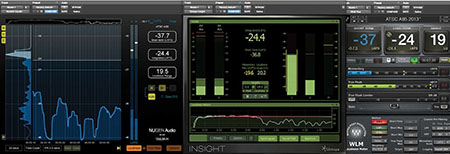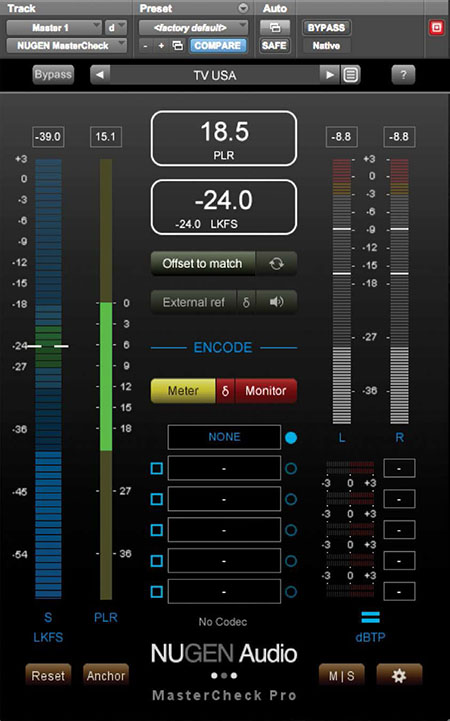The Effects of New Formats on Loudness
The face of television audio has developed some interesting new wrinkles since we last looked at loudness—namely, immersive audio, object-based audio and audio for personal devices. We’re just beginning to unwrap the specifics and demands of these new delivery formats as well as learning how to produce for them, but loudness is an important factor of each.
The best news on the loudness front is that measurements are still based on the ITU-R BS.1770 standards we’re already using. Existing loudness meters remain valid, though some updates will likely be required. First up, we’ll take a fresh look at the foundations of loudness before we examine the impact the new formats will have on it.
LOUDNESS METERS
Loudness meters are neither volume unit (VU) nor peak meters, but are K-weighted meters designed to measure loudness in a manner that more closely approximates how humans hear. They display Loudness K-weighted Relative to Full Scale (LKFS), where each unit of LKFS (aka Loudness Units (LU)) is equivalent to one decibel.

Fig. 1: Loudness meter
Measurement is done by first applying a pre-filter that simulates how a spherical human head acoustically influences audio; then a second-order high pass filter is applied. Next, a mean square calculation is performed on all channels before they are summed, with each surround channel getting a 0.5 dB bump in the calculation and the LFE being dropped from it.
Gating was added in BS.1770-2 to ensure that quiet passages and silence don’t unduly influence the reading, so these gates make up the final stage of measurement. Samples are taken in overlapping 400 ms blocks, with the first gate at –70 LKFS, and the second at –10 dB relative to the first gated measurement.
THE MEASUREMENTS
As we look at the measurements audio engineers will actually encounter, it’s important to remember that all loudness measurements are made over time. Therefore, each measurement will fluctuate throughout the program and displayed values will rarely, if ever, remain static.
The Momentary (M) reading is an ungated measurement of loudness over a sliding 400 ms window and is a good representation of loudness at a given moment. Short-term (S) is also ungated and displays loudness over a three-second continuously sliding window. Integrated (I) is the gated overall loudness of content from beginning to end and is the measurement used to ensure CALM Act compliance.
NEWER MEASUREMENTS
A few less familiar measurements include Loudness Range (LRA), Peak to Loudness Ratio (PLR) and Maximum True Peak Level (TPL).
Loudness Range is the overall variation between quiet and loud sounds within a given piece of content, but it’s really a little more complicated than that. According to EBU Technical Document 3342, Loudness Range is “Based on the statistical distribution of measured loudness.” So the measurement looks at the entirety of the content and uses a combination of absolute and signal-dependent gates to ensure that individual loud or quiet moments don’t skew readings.
Peak to Loudness Ratio measures the dynamic range of a mix and is primarily used for music production, with some interesting potential as a broadcast tool for mixers who want a measurement of the dynamic range of their mix. PLR is a real-time measurement, usually applied to the entire piece of content, though it could also be used to determine the dynamic range of individual sections of audio. Higher PLR numbers indicate a mix with a wider dynamic range and values closer to zero indicate less dynamic range.
Maximum True Peak Level is simply the highest audio level measured at a given point within the content. It should not be allowed to exceed either the –2 dB TP specification in ATSC A/85 or the True Peak value of the content delivery specifications.
NEW FORMAT LOUDNESS
When it comes to measuring loudness for immersive and object-based audio formats, testing seems to indicate that the loudness of immersive mixes closely track the loudness of rendered 5.1 or 7.1 full mixes.

Fig. 2: MasterCheck Pro meter showing PLR measurement
In e-Brief 352, from the AES Berlin 2017 in May, the authors presented data showing the loudness variation between an immersive movie mix rendered into a Dolby E-AC-3 5.1 mix. When decoded into multiple Speech Gated Loudness configurations the variation was a maximum of 0.3 LU, and maximum variation of 0.7 LU when decoded and replayed into multiple Relative-gated Loudness configurations.
Additional evidence that current loudness tools will work for NGA audio formats can be found in the Atoms Production Suite manual, which states that, “You should use the 7.1 full mix re-render for loudness measurement during post production to ensure that content meets delivery specifications.”
Suggestions have surfaced for specific multichannel loudness tools for NGA formats, but if measuring surround mixes is equivalent to measuring NGA mixes, then these new loudness tools may not be necessary.
PERSONAL DEVICE LOUDNESS
The outlook is a little murkier for personal devices such as mobile phones and tablets because there’s so much variation between them. With differing acoustic and electronic outputs, the potential listening options seem almost limitless. Content services seem to recognize the need for loudness management because most have instituted normalization, though not at the same loudness level.
Fortunately, work is already in progress to address the technical needs of these devices. The AES has one study group working on loudness standards for streaming and the AGOTTVS subcommittee is working on loudness standards for OTT and video streaming. Both AES groups have published preliminary guidelines and have broad support from the broadcast industry and content services. However, the sheer variety of available devices makes the labor of both AES groups extremely involved and technically challenging.
A lot has changed in the 14 years since Dolby introduced the LM-100, the first broadcast loudness meter, yet ITU-R BS.1770 and its refinements are holding up well in the face of new audio delivery formats, proving that it was a wise choice for modern loudness management tools. We’ll likely see more refined measurement algorithms in the future, as well as additional specialized measurements, but for now it appears that the loudness tools we’re using will continue to serve us for the foreseeable future.
Jay Yeary is a broadcast engineer and consultant who specializes in audio. He is an AES Fellow and a member of SBE, SMPTE, and TAB. He can be contacted throughTV Technologymagazine or attransientaudiolabs.com.
Get the TV Tech Newsletter
The professional video industry's #1 source for news, trends and product and tech information. Sign up below.
